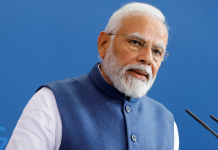
IN HIS Boatman series, Kolkata-based artist Ganesh Pyne painted a boat ferrying a man to harbour. Only, the man is not alive and the river is the one that the dead cross. As news of Pyne’s passing broke, many artists and critics remembered this image as an insight into a man obsessed with death, pain and solitude. Along with Bikash Bhattacharjee, Jogen Chowdhury and Somnath Hore, Pyne was a cornerstone of the Bengal School of Art and commanded some of the highest prices by an Indian artist from the 1980s to the ’90s. Yet he was a recluse who spent his life creating a language of dream painting.
“He was a poet of melancholia,” remembers art critic Ranjit Hoskote. “He explored elements of the subconscious; the mercenary, the demons and the angels were aspects of the self split from his waking reality.” This self was forged early in his childhood in Kolkata. Born in 1937, growing up lost in his grandmother’s fairytales, Pyne’s life was uprooted by the communal violence of 1946. He encountered death closely, which surfaced in his art his entire life. His cultural inheritance included Abanindranath Tagore, Rembrandt and Walt Disney. Through them all, he created a philosophy uniquely his own. According to Hoskote, he represented no school, no movement, but his own artistic terrain, a view shared by artist Sanjay Bhattacharya, Pyne’s junior from the Government College of Art and Craft, Kolkata. “You shouldn’t use just the Bengal School brand for him. His blend of skill and his intellect make him Ganesh Pyne. But his abstraction carried a universal appeal, which is why his work can stand side by side with the masters.”
His recurring motifs were of a derelict building filled with darkness, used in a painting after his brother’s death, crumbling temples drawn from the destruction of 1946, and skeletal imagery. He would use animals repeatedly, in different clothes and appearances, as a way, says Hoskote, of the self trying on different roles. Yet, Pyne was not a morbid man. Forces of negation were countered with those of affirmation — a lamp, a fire, stars — as critic Ella Datta points out. She adds that even though there was a touch of melancholia to his persona, the few people he allowed into his life discovered a delightful and well-read man. Boatman is famously inspired from Bangla poet Shakti Chattopadhyay. Pyne would jot down lines from texts, create sketches around them and from this mix, his paintings would emerge.
His meditative content was offset by his form of tempera and gouache. Artist Anjole Ela Menon says, “His work was marked by deft detail, a sombre palette and an invented mythology featuring kings and clowns, quite often embracing the bizarre. Much of his work, that commanded prices unheard of in those early days, was done in watercolour on paper in the tradition of Bengal, yet the imagery stemmed from his own rich imagination, and was a celebration of the small format.”
Yet, Pyne’s relationship with the art market was fraught. Datta recalls his insecurity about commercial demand. “Today I please the collector, what happens tomorrow?” he once asked her. Nor was he keen on exhibitions, preferring to show three paintings at a time with the Society of Contemporary Artists, Kolkata. Only in 1998 did the Centre of International Modern Art, Kolkata hold his first major exhibition. However, as rare as his public outings were, Pyne will be remembered as the quiet man whose canvases captivated many with their vivid, burnished quality and the alchemy of the real and the fantastic.
aradhna@tehelka.com













